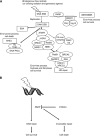The role of PARP in DNA repair and its therapeutic exploitation
- PMID: 21989215
- PMCID: PMC3208503
- DOI: 10.1038/bjc.2011.382
The role of PARP in DNA repair and its therapeutic exploitation
Abstract
Historically, PARP inhibitors (PARPi) were developed to potentiate the cytotoxic effect of certain chemotherapeutic agents and are currently being investigated in combination with chemotherapy in diverse cancer types. These agents are also radiosensitisers and clinical trials of PARPi with concurrent radiation are required. It has long been recognised that defective DNA repair pathways lead to tumour susceptibility. Recent studies indicate that tumour cells with defective homologous recombination (HR) repair pathways, the classic example being BRCA mutations, are exquisitely sensitive to PARPi. Defects in HR are not restricted to BRCA-associated tumours and other cancer types may be enriched for HR defects and hence susceptible to PARP inhibition. The identification of predictive markers for sensitivity to PARP inhibition is a priority area for research.
Figures


References
-
- Ali M, Telfer BA, McCrudden C, O’Rourke M, Thomas HD, Kamjoo M, Kyle S, Robson T, Shaw C, Hirst DG, Curtin NJ, Williams KJ (2009) Vasoactivity of AG014699, a clinically active small molecule inhibitor of poly(ADP-ribose) polymerase: a contributory factor to chemopotentiation in vivo? Clin Cancer Res 15: 6106–6112 - PMC - PubMed
-
- Bauer PI, Mendeleyeva J, Kirsten E, Comstock JA, Hakam A, Buki KG, Kun E (2002) Anti-cancer action of 4-iodo-3-nitrobenzamide in combination with buthionine sulfoximine: inactivation of poly(ADP-ribose) polymerase and tumor glycolysis and the appearance of a poly(ADP-ribose) polymerase protease. Biochem Pharmacol 63: 455–462 - PubMed
-
- Bedikian AY, Papadopoulos NE, Kim KB, Hwu WJ, Homsi J, Glass MR, Cain S, Rudewicz P, Vernillet L, Hwu P (2009) A phase IB trial of intravenous INO-1001 plus oral temozolomide in subjects with unresectable stage-III or IV melanoma. Cancer Invest 27: 756–763 - PubMed
Publication types
MeSH terms
Substances
LinkOut - more resources
Full Text Sources
Other Literature Sources

